| |
Vitamin D Deficiency in Older Men
|
| |
| |
J Clin Endocrin Metab. First published ahead of print January 27, 2009 as doi:10.1210/jc.2008-1784
Eric Orwoll1, Carrie M. Nielson1, Lynn M. Marshall1, Lori Lambert1, Kathleen F. Holton1,
Andrew R. Hoffman2, Elizabeth Barrett-Connor3, James M. Shikany4, Tien Dam3, Jane A.
Cauley5 for the Osteoporotic Fractures in Men (MrOS) Study Group
1Bone and Mineral Unit, Oregon Health and Science University, Portland, OR, 2Palo Alto VA
Medical Center, Palo Alto CA, 3University of California San Diego, San Diego, Ca, 4University
of Alabama, Birmingham AL, 5Department of Epidemiology, University of Pittsburgh, PA
Abstract
Context: Vitamin D deficiency is not adequately evaluated in older men
Objective: To determine the prevalence of deficiency and identify risk factors for its occurrence
Design: A cross sectional evaluation of 1606 older men enrolled in the Osteoporotic Fractures in Men Study
Setting: General community
Participants: A randomly selected subcohort of a large population of men from six US
communities
Main outcome measures: Serum concentrations of 25(OH)D2 and 25(OH)D3 were measured
using mass spectrometry
Results: Deficiency (25(OH)D <20 ng/mL) was present in 26% and insufficiency (< 30 ng/mL) in 72%. Deficiency was particularly common among men during the winter and spring (especially in the Northern communities), and in the oldest and more obese men. For instance, in Caucasian men in winter or spring who were >80 years, did not engage in lawn/garden work, and had a BMI >25 and vitamin D intake <400 IU/day,, the prevalence of vitamin D deficiency was 86%. 25(OH)D2 levels were present in a small fraction of men, and accounted for a low proportion of total 25(OH)D levels. The use of vitamin D supplements was reported by 58% of men, but supplement use had a small effect on total 25(OH)D levels and despite supplement use low levels remained frequent.
Conclusions: Vitamin D deficiency is common in older men, and is especially prevalent in obese, sedentary men living at higher latitudes. Use of vitamin D supplements at levels reported here did not result in adequate vitamin D nutrition
Introduction
Vitamin D is necessary for a wide variety of essential biological functions such as bone and mineral metabolism, muscle function, and immunity (1). Moreover, vitamin D insufficiency has been noted to be present in a variety of populations (2) and is implicated in the causation of common disorders including osteoporosis and fractures, falls, cancer, psoriasis and others
(3). Vitamin D deficiency is of particular interest because it is easily, safely and inexpensively corrected with adequate supplementation. Although findings have been somewhat inconsistent, trials of the effects of vitamin D supplementation suggest beneficial effects on important clinical outcomes (2, 4, 5). As a result, increased attention has been directed at
improving vitamin D nutrition, including recent recommendations to increase the routine intake of vitamin D (6). Complicating the assessment of vitamin D status are concerns about
measurement technique. Immunoassay and protein binding based methods have yielded
discrepant results (7) and some of these assays may yield spurious levels when compared to liquid chromatography/mass spectrometry (8-10).
Despite concerns about vitamin D adequacy in the elderly there remain too few large, community based studies that use accurate and precise 25(OH)D assays to determine the extent of deficiency and identify those at risk. For instance, there are inadequate data about vitamin D levels in older men, a group commonly affected by disorders linked to vitamin D insufficiency (e.g. falls, fractures, cancer). To more completely undrstand vitamin D status in a large population of elderly men and identify factors with potential for clinical intervention, we measured levels of 25OHD2 (a sterol produced in yeast and obtained primarily from nutritional supplements and supplemented foods) and 25OHD3 (obtained from nutritional supplements, supplemented foods, food and UV irradiation of the skin) .
Methods
Study participants
Participants were enrolled in the Osteoporotic Fractures in Men Study (MrOS). From March 2000 through April 2002, 5995 community-dwelling men at six clinical centers in the United States (Birmingham, Alabama; Minneapolis, Minnesota; Palo Alto, California; Monongahela Valley near Pittsburgh, Pennsylvania; Portland, Oregon; and San Diego, California) agreed to participate in a study of healthy aging, with a focus on osteoporosis and fractures. Eligible men were ≥65 years old, without bilateral hip replacements, and able to walk without assistance from another person. Details of the MrOS design and cohort have been described (11, 12). The Institutional Review Board at each center approved the study and written consent was obtained from all participants.
Baseline serum for 25(OH)D assays were from 1608 participants who were randomly chosen from 5908 participants in the cohort who had ≥ 1 vial of serum available. One participant had insufficient serum to complete the assays. Another man had 25(OH)D levels >3 SD above the mean (75.6 ng/mL) and was omitted for analyses, leaving 1606 participants' results.
In addition, assays were performed on a second serum sample from men who volunteered for a second visit an average of 1.9 years after baseline to participate in a follow-up visit. The results from those men who were also in the random sample selected at baseline (n=352) were used to examine the stability of 25(OH)D levels over time.
25(OH)D assays
Fasting morning blood was collected, serum was prepared immediately after phlebotomy, and was stored at -70°C in vials foil-wrapped to prevent light exposure. Samples remained frozen until assay.
Measures for 25(OH)D2 (derived from ergocalciferol) and 25(OH)D3 (derived from cholecalciferol) were performed at the Mayo Clinic using mass spectrometry as
previously described (13). Deuterated stable isotope (d3-25-hydroxyvitamin D) was
added to a 0.2-mL serum sample as internal standard. 25-hydroxyvitamin D2, D3, and
the internal standard were extracted using acetonitrile precipitation. The extracts were
further purified online and analyzed by LCMS/MS using multiple reaction monitoring.
25(OH)D2 and 25(OH)D3 were reported individually. The minimum detectable limit
for 25(OH)D2 was 4 ng/mL and for 25(OH)D3 was 2 ng/mL. Aliquots of a single serum pool were included in alternate assay runs. Using the pooled serum, the inter-assay CV for 25(OH)D3 was 4.4% and the intra-assay CV was 4.9%. In the study of stability of 25(OH)D levels over time, baseline and follow-up samples were run sequentially within an assay run and the order of the pair in the run was randomly determined.
Total 25(OH)D was the sum of 25(OH)D3 and 25(OH)D2 levels. Baseline total 25(OH)D levels were categorized as normal, insufficient or deficient according to the definitions proposed by Holick (3). Deficiency was defined as <20 ng/mL, insufficiency as 20-29 ng/mL and
sufficiency as 30-149 ng/mL. No participant had "toxic" levels (> 150 ng/mL). We also
report the proportion of participants with levels <10 ng/mL.
Other Measures
Demographic factors, smoking and alcohol consumption and medications were determined by questionnaire. Physical activity was assessed with the Physical Activity Score for the Elderly (PASE) (14). In PASE, walking for exercise was estimated from the questions "Over the past 7 days, how often did you take a walk outside your home or yard for any reason? For example, for fun or exercise, walking to work, walking the dog, etc.?" During the
clinic interview, an additional question was asked: "Do you take walks for exercise, daily or almost every day?" Outdoor activity was determined from the question "During the past 7 days, did you engage in any of the following activities: Lawn work or yard care, including snow or leaf removal, wood chopping, etc.? Outdoor gardening?" A modified Block food
frequency questionnaire was administered to assess usual dietary and supplement intake
over the past year (Block Dietary Data Services, Berkeley, CA) (15). Vitamin D intake from food and supplements was determined but information did not include whether vitamin D supplements included D3 or D2; hence only total 25-OHD content was considered. Participants brought in all medications used within the last 30 days. A computerized dictionary, based on the original Established Populations for Epidemiologic Studies of the Elderly (EPESE) coding system (16) was used to categorize the medications. Each medication was matched to its ingredient(s) based on the Iowa Drug Information Service (IDIS) Drug Vocabulary (College of Pharmacy, University of Iowa, Iowa City, IA). Height
(cm) was measured on Harpenden stadiometers, and weight (kg) was measured on standard balance beam or digital scales. Body mass index (BMI) was calculated as kg/m2.
Statistical analyses
The distributions of 25(OH)D, 25(OH)D3 and detectable 25(OH)D2 levels were approximately normal. However, because the majority of 25(OH)D2 results were undetectable, the variable was examined both as dichotomous (detectable or not) and as continuous if in the detectable
range (>4 ng/mL) and both results are reported. Analyses using 25(OH)D2 as a continuous variable utilized only participants with detectable levels. Pearson correlations were calculated for each 25(OH)D measure and continuous variables collected at baseline, including age, body size measures, and reported intake of vitamin D and calcium from diet and supplements. Means and standard deviations of baseline total 25(OH)D, 25(OH)D2, and 25(OH)D3 were calculated by participant characteristics, including demographic and physical activity variables, collected at the baseline exam. ANOVA and t tests were used to compare means, and χ2 tests to compare proportions.
Mean 25(OH)D concentrations were evaluated by season and clinic site. Season of baseline visit was coded as winter (January-March), spring (April-June), summer (July-September), and fall (October-December). Clinic sites also differed in their climate and latitude, which
may affect participants' exposure to sunlight; therefore, 25(OH)D levels were evaluated by site. Absolute change in 25(OH)D levels between baseline and a subsequent visit (1.9 ± 0.4 years later) were calculated for 352 participants who had baseline and follow-up measures and these levels were normalized for season of collection. Seasonal normalization was accomplished as follows. A 5-category "season change" variable was created to describe whether a participant's follow-up visit was 1) in the same season as baseline, 2) in a "lighter" season than baseline (e.g., baseline visit was in winter and follow-up was in spring), 3) in a "much lighter" season (e.g., baseline visit was in winter and follow-up was in summer), and so on for "dark" and "much darker" season changes. Mean differences between baseline and follow-up in 25(OH)D and 25(OH)D3 were calculated for participants in each of the 5
categories of the season change variable. The mean differences were added to each follow-up value. For example, participants whose follow-up visit was in a much darker season had an average 5.55 ng/mL lower 25(OH)D3 value at follow-up than at baseline. Therefore, 5.55 ng/mL was added to each participant's 25(OH)D3 value in that season change category. Values in otherseason-change categories were adjusted similarly.
Factors associated with vitamin D deficiency were identified using logbinomial models (PROC GENMOD). This method provides better estimates of prevalence ratios than does logistic
regression for common outcomes, such as vitamin D deficiency (17). That is, logistic
regression would be expected to overestimate strengths of association reported in this study (18).Prevalence ratio estimates for deficiency were calculated for each of several baseline characteristics alone and after adjustment for age, season, and race. Upon this basic model adjusted for these three variables, a multivariable model was constructed using each of the variables associated with vitamin D deficiency with a p<0.10 in bivariate analysis. A likelihood ratio test was used to determine whether model fit improved significantly (p<0.05)
with the addition of new variables. Additional variables were added to the multivariate model in the order of lowest to highest p value (among those with p<0.05) until no additional variable significantly improved the model fit as assessed by the likelihood ratio test.
All analyses were conducted using SAS version 9.1.2 (SAS Institute, Cary, NC, USA).
Results
Characteristics of study participants are shown in Table 1. The average age was
73.8+5.9 years with a range of 65-99. Most were Caucasian; 10.3% were from other
racial and ethnic groups. The average serum total 25(OH)D level was 25.1 ± 7.9 ng/mL
(range 3.1-58.3 ng/mL). 71.1% had 25(OH)D levels < 30 ng/mL, 25.7% had levels < 20 ng/mL, and 2.9% had levels < 10 ng/mL.
352 men had measures of 25(OH)D in serum obtained on two occasions 1.9 ± 0.4 years apart. After adjusting for season there were no statistically significant differences in the means of the two measurements, and differences between measures in individuals were generally
small. The partial correlation coefficient for baseline and second visit total 25(OH)D,
adjusted for season change, was 0.72 (p<0.0001). All the 151 men with two measures who were classified as deficient at baseline were also deficient at the second visit.
Almost all circulating 25(OH)D was derived from vitamin D3; only 26% had detectable levels of 25(OH)D2 and mean levels were low (8.4 ± 3.3 ng/mL) in those in whom it was detectable. The level of total 25(OH)D was weakly associated with the amount of vitamin D reported from supplement use (r= 0.28, p <0.0001). Those who reported supplement use had slightly
higher total 25(OH)D levels and more often had detectable levels of 25(OH)D2 (43.6% vs 1.5%).
Age, obesity and race
Total 25(OH)D levels tended to be lower in older men (r = -0.09, p=0.0002)(Table 2). In men aged 80-84 years 31% had levels < 20 ng/mL, and in men >85 years 40% were deficient (Figure 1A). 25(OH)D3 levels were lower as age increased (r= -0.10, p< 0.0001), but older men tended to have slightly higher 25(OH)D2 levels (r = 0.11, p= 0.03). Obesity was also associated with lower total 25(OH)D levels (Table 2). Those with BMI in the normal range (<25 kg/m2) 21% had 25(OH)D levels < 20 ng/mL, in overweight men (BMI 25-29 kg/m2) 24.5% had vitamin D deficiency, and in obese men (BMI>30 kg/m2) 33.6% had vitamin D deficiency and 4.3% had levels <10 ng/mL. Those who were very obese (BMI >35), 53.3% were deficient (Figure 1B).
Total 25(OH)D levels were lower in African Americans (18.5 ± 8.8 ng/mL) than in Caucasians (25.5 ± 7.8 ng/mL). Whereas average 25(OH)D2 levels were similar (27.8% detectable, mean= 9.6 vs 26.6% detectable, mean= 8.3 ng/mL, respectively), 25(OH)D3 levels were lower in African Americans (15.8 vs 23.3 ng/mL). 64.8% and 22.2% of African Americans had 25(OH)D levels below 20 ng/mL and 10 ng/mL, respectively, whereas 23.2% and 1.8% of Caucasians were below those levels. Hispanics also had lower 25(OH)D levels (Table 2).
Physical activity
Higher activity level (PASE score) and amount of outside activity were associated with higher 25(OH)D levels (Table 2). For instance, those who reported no lawn work or gardening, mean total 25(OH)D was 23.2 ng/mL and 22.6% were deficient, whereas men who reported at least
one outdoor yard activity had a mean 25(OH)D of 25.6 ng/mL (p<0.0001), and 35.2% were deficient.
Vitamin D from diet and supplements
Diet supplied small amounts of vitamin D (mean intake 163 + 115 IU/day); only 10
(0.6%) received the recommended daily allowance of 600 IU/day from diet alone (Table 1), and dietary intake correlated weakly with total 25(OH)D levels (r= 0.08). The use of vitamin D supplements was reported by 58.5%, but none reported taking >600 IU/day. Supplements were associated with higher total 25(OH)D levels (Table 2). 15.5% who reported supplement use had 25(OH)D levels < 20 ng/mL, whereas 39.6% who did not report supplement use had concentrations below that level. Nevertheless, a high proportion had vitamin D insufficiency with all supplement doses (%with 25(OH)D levels <30 ng/mL: supplement intake <200 IU/day - 83.6%, 200 to <400 IU - 68.3%, 400 to <600 IU - 69.3%, and 600 IU - 61.3%).
Multivariable analyses
In bivariate analyses, several factors were associated with vitamin D deficiency (<20 ng/mL) (Table 3). After adjustment for these factors, older age, obesity, Black or Hispanic race, and winter or spring season remained independently associated with a greater prevalence of deficiency. For instance, the risk of vitamin D deficiency approximately doubled with: age >85 years, BMI >35 kg/m2, Black race and winter season. Dietary intake of vitamin D of at
least 400 IU and lawn work/gardening were both associated with a lower prevalence of deficiency. The additive impact of these risk factors was considerable. In Caucasian men who were >80 years, with a BMI >25, who had a vitamin D intake <400 IU/day, did not engage in lawn/garden work, and who were sampled in winter or spring, the prevalence of vitamin D deficiency was 86%; while there was a prevalence of 24% in younger, thinner men who had higher vitamin D intakes, who were sampled in summer or fall and who engaged in lawn/garden work.
Discussion
In a cohort of older men in the United States vitamin D deficiency and insufficiency was common. Approximately one quarter had a 25(OH)D level below that commonly considered to represent frank deficiency (<20 ng/mL) and the majority had levels considered insufficient (<30 ng/mL). Deficiency was particularly common during the winter and spring months (especially in the Northern communities), and in the oldest and more obese. In fact, 86% with multiple risk factors were deficient. Since vitamin D deficiency has been linked to a variety of
common diseases, these results may be of considerable public health relevance. Importantly, our data demonstrated that the level of 25(OH)D varied little in sera obtained approximately 2 years apart, indicating that vitamin D status is stable over time and suggesting that many have longstanding vitamin D deficiency.
There is uncertainty concerning the levels of 25(OH)D levels that are adequate, but because measures of serum parathyroid hormone tend to be higher in those with 25(OH)D levels < 30 ng/mL (19), that concentration is considered sufficient to prevent secondary hyperparathyroidism. Less than 30% of our population achieved that goal. One quarter of older men had 25(OH)D levels < 20 ng/mL, concentrations associated with more severe consequences (3). These results are similar to those reported in other studies (20-22) and confirm that vitamin D deficiency is widespread.
Considerable variation has been noted in measurements of 25(OH)D levels in multicenter comparisons of assay performance (7-9), apparently reflecting inconsistency in between methods or laboratories. Thus, some of the difficulty in estimating what levels of 25(OH)D are adequate, and in surveying the population burden of vitamin D deficiency, may result from the lack of standardization of assay approaches. We measured 25(OH)D levels using liquid chromatography/mass spectrometry, and assay quality control revealed excellent performance.
25(OH)D3 was present in much higher concentrations than was 25(OH)D2. In fact, only one quarter of these men had detectable levels of 25(OH)D2 and few who did not take supplements had detectable 25(OH)D2. These results suggest that many older men in the US have minimal exposure to vitamin D2. Vitamin D deficiency is thought to be less common in the US because of vitamin D supplementation of dairy products (21, 23, 24); many of the men in MrOS reported using daily vitamin D supplements, and in fact the levels of total
25(OH)D in these men were higher. Nevertheless, the prevalence of vitamin D deficiency remained high even in supplement users, and 39.6% of supplement users were deficient (< 20 ng/mL). These results strengthen the impression (25) that commonly used supplement doses are inadequate to ensure vitamin D nutrition. To some extent this is not surprising since Holick et al (26) recently reported that for every 100 IU of vitamin D2 or vitamin D3 ingested, there is an increase in circulating 25(OH)D levels of only 1 ng/mL., providing some explanation for why men reporting supplement use have marginally higher concentrations. In addition, we also estimated the intake of vitamin D from diet. On average it was small and probably contributed little to overall vitamin D nutrition. In combination, the apparently small effects of supplements and diet support that endogenous production from skin UV exposure is the primary source of vitamin D in older men.
Other studies reported that aging (2, 27), obesity (28-30), and winter season (31) are associated with lower 25(OH)D levels. We demonstrate that those factors have important effects on the prevalence of vitamin D deficiency; 53.3% of the most obese men were deficient and almost half ≥85 years were deficient. The winter season considerably increased the proportion classified as deficient. Moreover, we showed that these are independent predictors of vitamin D deficiency, and that the cumulative effects of these factors are
impressive. The great majority with multiple risk factors were deficient. This information suggests that obese, older men may particularly benefit from vitamin D supplementation, especially in the winter and spring, and that trials are warranted to assess the potentially widespread benefits.
The study has several major strengths. To our knowledge this is the largest study of 25(OH)D levels in elderly men. It draws from a cohort of community dwelling men from diverse geographical regions of the US and includes the availability of information concerning relevant seasonal, nutritional and lifestyle factors. In addition, 25(OH)D measurements were performed using mass spectrometry-based assays with high precision, thus avoiding potential artifacts associated with other approaches (8, 9, 32, 33). These assay methods also allowed us to independently determine both 25(OH)D2 and 25(OH)D3 levels. On the other hand, study
weaknesses included the volunteer nature of the participants that limits the generalizability of the results. For instance, the prevalence of vitamin D deficiency would be expected to be higher in less healthy men (34). Nevertheless, the likelihood that our results apply to other
older US men is strengthened by the observation that means for height, weight, and BMI among black, Hispanic, and white men studied here are nearly identical to the race/ethnicity-specific means from the NHANES 1999-2000 reference data for men aged ≥ 60 years (35). Finally, no women were studied, and the proportion of nonwhite participants was limited.
In summary, vitamin D deficiency is very common in older US men, especially among the most elderly and obese, and during the winter in northern latitudes. In many, prevalent vitamin D deficiency appears to be a longstanding condition, rather than a recent occurrence. Since older men are commonly afflicted with disorders potentially linked to vitamin D deficiency, and some studies have suggested benefit from supplementation, there is a need to
further examine the usefulness of vitamin D supplements in clinical trials with adequate power to address multiple outcomes.


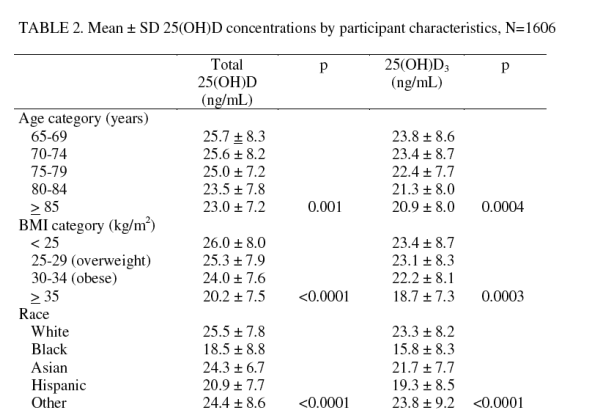
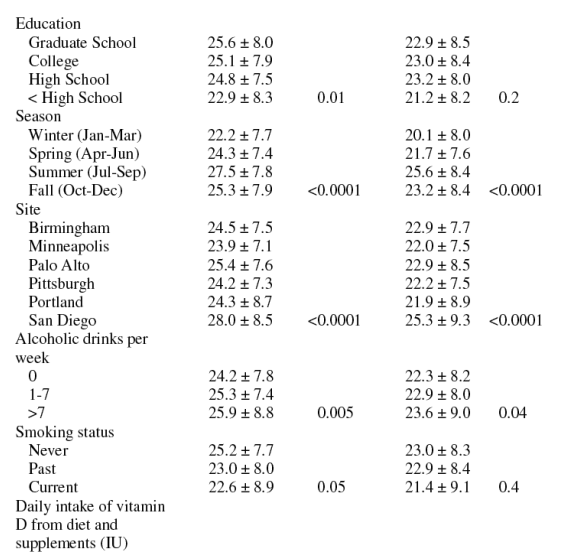
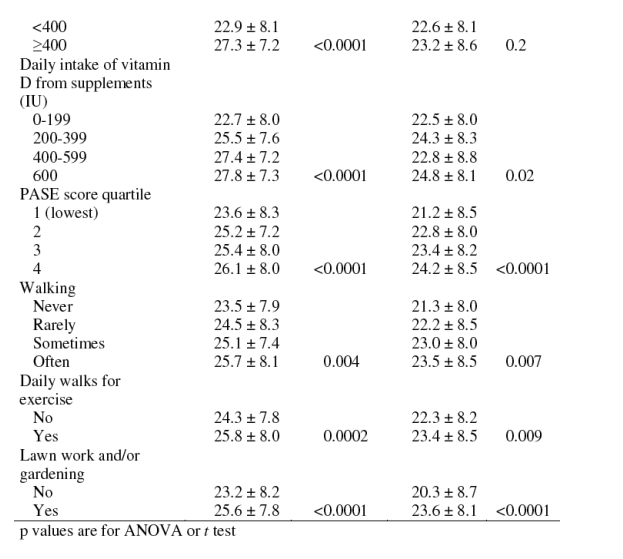
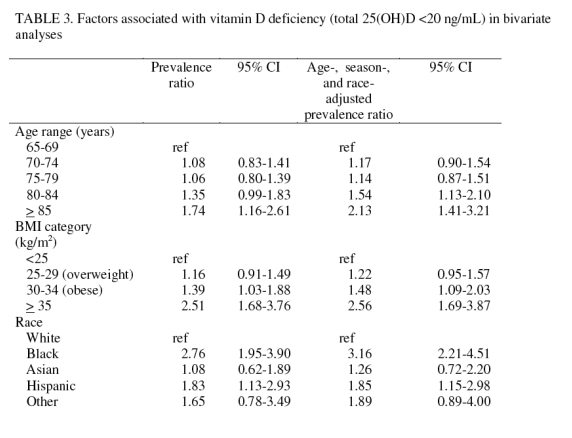
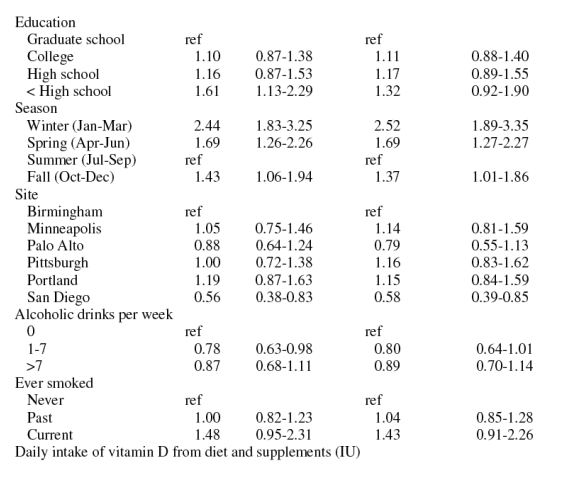
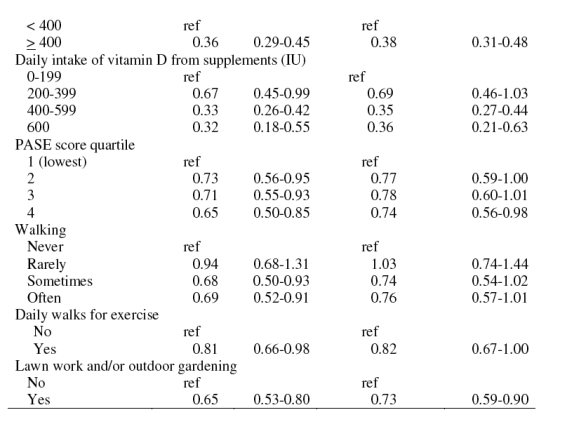
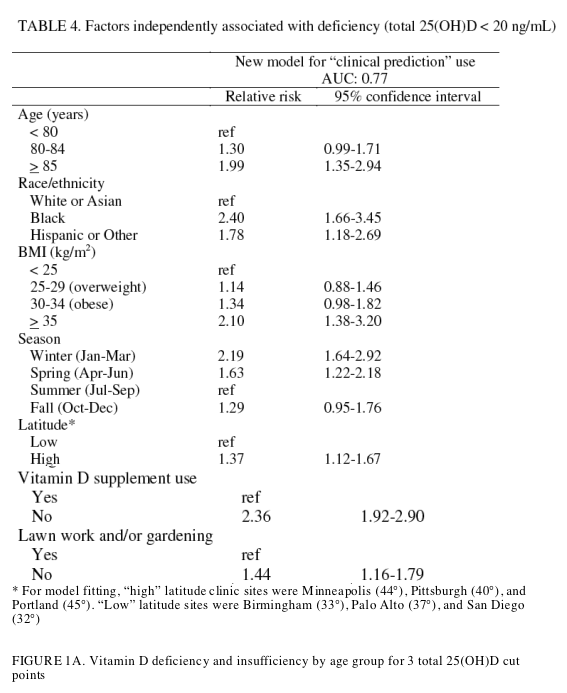

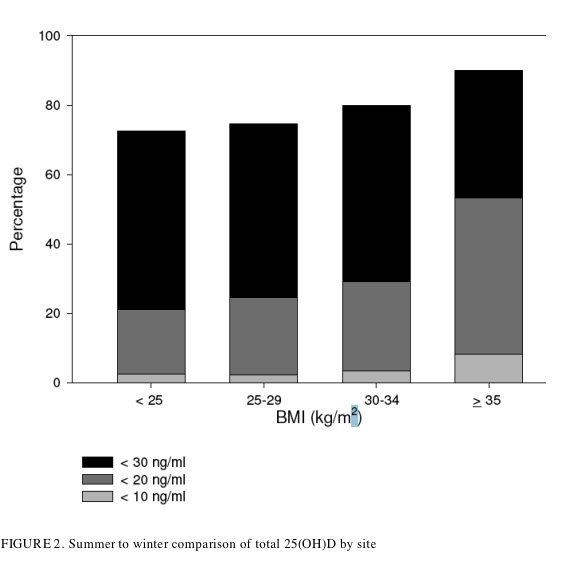
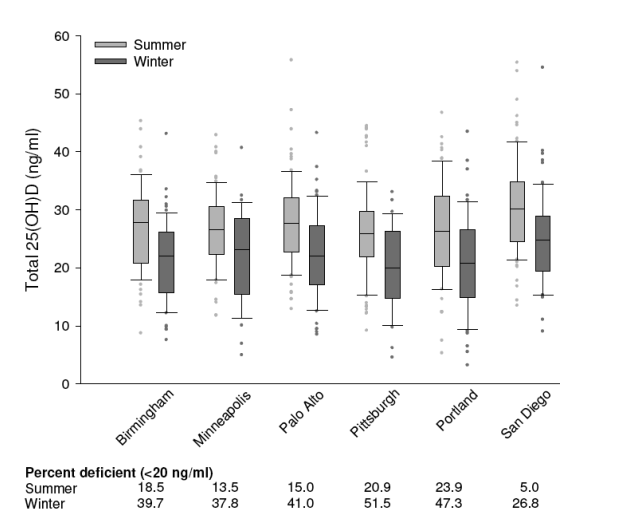
References
1. DeLuca HF 2004 Overview of general physiologic features and functions of
vitamin D. American Journal of Clinical Nutrition 80:1689S-1696S
2. Holick MF 2006 High prevalence of vitamin D inadequacy and implications for
health. Mayo Clinic Proceedings 81:353-373
3. Holick MF 2007 Vitamin D Deficiency. N Engl J Med 357:266-281
4. 2007 Journal of Bone and Mineral Research Supplement 2. Journal of Bone and
Mineral Research, Washington, D.C., 2007, pp V1-V111
5. Bischoff-Ferrari HA, Willett WC, Wong JB, Giovannucci E, Dietrich T,
Dawson-Hughes B 2005 Fracture prevention with vitamin D supplementation: a
meta-analysis of randomized controlled trials. JAMA 293:2257-2264
6. Bischoff-Ferrari HA 2008 Optimal serum 25-hydroxyvitamin D levels for
multiple health outcomes. Adv Exp Med Biol 624:55-71
7. Hypponen E, Turner S, Cumberland P, Power C, Gibb I 2007 Serum 25-
hydroxyvitamin D measurement in a large population survey with statistical
harmonization of assay variation to an international standard. J Clin Endocrinol
Metab 92:4615-4622
8. Lips P, Chapuy MC, Dawson-Hughes B, Pols HA, Holick MF 1999 An
international comparison of serum 25-hydroxyvitamin D measurements.
Osteoporos Int 9:394-397
9. Binkley N, Krueger D, Cowgill CS, Plum L, Lake E, Hansen KE, DeLuca
HF, Drezner MK 2004 Assay Variation Confounds the Diagnosis of
Hypovitaminosis D: A Call for Standardization. J Clin Endocrinol Metab
89:3152-3157
10. Jones G, Horst R, Carter G, Makin HLJ 2007 Contemporary Diagnosis and
Treatment of Vitamin D Related Disorders. Journal of Bone & Mineral Research
22:V11-V15
11. Orwoll E, Blank JB, Barrett-Connor E, Cauley J, Cummings S, Ensrud K,
Lewis C, Cawthon PM, Marcus R, Marshall LM, McGowan J, Phipps K,
Sherman S, Stefanick ML, Stone K 2005 Design and baseline characteristics of
the osteoporotic fractures in men (MrOS) study - A large observational study of
the determinants of fracture in older men. Contemp Clin Trials 26:569-585
12. Blank JB, Cawthon PM, Carrion-Petersen ML, Harper L, Johnson JP,
Mitson E, Delay RR 2005 Overview of recruitment for the osteoporotic fractures
in men study (MrOS). Contemp Clin Trials 26:557-568
13. Singh RJ, Taylor RL, Reddy GS, Grebe SK 2006 C-3 epimers can account for
a significant proportion of total circulating 25-hydroxyvitamin D in infants,
complicating accurate measurement and interpretation of vitamin D status. J Clin
Endocrinol Metab 91:3055-3061
14. Washburn RA, Smith KW, Jette AM, Janney CA 1993 The Physical Activity
Scale for the Elderly (PASE): development and evaluation. J Clin Epidemiol
46:153-162
15. Block G, Hartman AM, Naughton D 1990 A reduced dietary questionnaire:
development and validation. Epidemiology 1:58-64
16. Pahor M, Chrischilles EA, Guralnik JM, Brown SL, Wallace RB, Carbonin
P 1994 Drug data coding and analysis in epidemiologic studies. European Journal
of Epidemiology 10:405-411
17. Spiegelman D, Hertzmark E 2005 Easy SAS Calculations for Risk or
Prevalence Ratios and Differences. Am J Epidemiol 162:199-200
18. Deddens JA, Petersen MR Approaches for estimating prevalence ratios. Occup
Environ Med 65:481
19. Chapuy MC, Preziosi P, Maamer M, Arnaud S, Galan P, Hercberg S,
Meunier PJ 1997 Prevalence of vitamin D insufficiency in an adult normal
population. Osteoporos Int 7:439-443
20. Saquib N, Von Muhlen DG, Garland CF, Barret-Conner E 2006 Serum 25-
hydroxyvitamin D, parathyroid hormone, and bone mineral density in men: the
Rancho Bernardo study. Osteoporos Int 17:1734-1741
21. Lips P 2001 Vitamin D deficiency and secondary hyperparathyroidism in the
elderly: consequences for bone loss and fractures and therapeutic implications.
Endocr Rev 22:477-501
22. Hannan MT, Litman HJ, Araujo AB, McLennan CE, McLean RR,
McKinlay JB, Chen TC, Holick MF 2008 Serum 25-hydroxyvitamin D and
bone mineral density in a racially and ethnically diverse group of men. J Clin
Endocrinol Metab 93:40-46
23. McKenna MJ 1992 Differences in vitamin D status between countries in young
adults and the elderly. American Journal of Medicine 93:69-77
24. van Schoor NM, Visser M, Pluijm SM, Kuchuk N, Smit JH, Lips P 2008
Vitamin D deficiency as a risk factor for osteoporotic fractures. Bone 42:260-266
25. Vieth R, Bischoff-Ferrari H, Boucher BJ, Dawson-Hughes B, Garland CF,
Heaney RP, Holick MF, Hollis BW, Lamberg-Allardt C, McGrath JJ,
Norman AW, Scragg R, Whiting SJ, Willett WC, Zittermann A 2007 The
urgent need to recommend an intake of vitamin D that is effective.[comment].
American Journal of Clinical Nutrition 85:649-650
26. Holick MF, Biancuzzo RM, Chen TC, Klein EK, Young A, Bibuld D, Reitz
R, Salameh W, Ameri A, Tannenbaum AD 2008 Vitamin D2 is as effective as
vitamin D3 in maintaining circulating concentrations of 25-hydroxyvitamin D. J
Clin Endocrinol Metab 93:677-681
27. Sherman SS, Hollis BW, Tobin JD 1990 Vitamin D status and related
parameters in a healthy population: the effects of age, sex, and season. J Clin
Endocrinol Metab 71:405-413
28. Holick MF 2004 Vitamin D: importance in the prevention of cancers, type 1
diabetes, heart disease, and osteoporosis. Am J Clin Nutr 79:362-371
29. Wortsman J, Matsuoka LY, Chen TC, Lu Z, Holick MF 2000 Decreased
bioavailability of vitamin D in obesity.[erratum appears in Am J Clin Nutr. 2003
May;77(5):1342]. American Journal of Clinical Nutrition 72:690-693
30. Snijder MB, van Dam RM, Visser M, Deeg DJ, Dekker JM, Bouter LM,
Seidell JC, Lips P 2005 Adiposity in relation to vitamin D status and parathyroid
hormone levels: a population-based study in older men and women. Journal of
Clinical Endocrinology & Metabolism 90:4119-4123
31. Webb AR, Pilbeam C, Hanafin N, Holick MF 1990 An evaluation of the
relative contributions of exposure to sunlight and of diet to the circulating
concentrations of 25-hydroxyvitamin D in an elderly nursing home population in
Boston. Am J Clin Nutr 51:1075-1081
32. Holick MF 2005 25-OH-vitamin D assays.[comment]. J Clin Endocrinol Metab
90:3128-3129
33. Fradinger EE 2005 Letter re: 25-OH-vitamin D assays.[comment]. J Clin
Endocrinol Metab 90:6337-6338; author reply 6338
34. Thomas MK, Lloyd-Jones DM, Thadhani RI, Shaw AC, Deraska DJ, Kitch
BT, Vamvakas EC, Dick IM, Prince RL, Finkelstein JS 1998 Hypovitaminosis
D in medical inpatients. N Engl J Med 338:777-783
35. McDowell MA, Fryar CD, Hirsch R, Ogden CL 2005 Anthropometric
reference data for children and adults: U.S. population, 1999-2002. Advance
Data:1-5
|
|
| |
| |
|
|
|